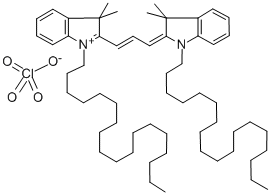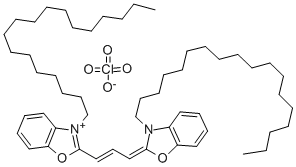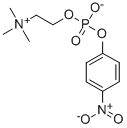TMA-DPH [N,N,N-Trimethyl-4-(6-phenyl-1,3,5-hexatrien-1-yl)phenylammonium, p-toluenesulfonate] , ≥95% , 115534-33-3
Synonym(s):
1-(4-Trimethylammoniophenyl)-6-phenyl-1,3,5-hexatriene p-toluenesulfonate;1,6-Diphenyl-1,3,5-hexatriene-4′-trimethylammonium tosylate;4′-(Trimethylammonio)diphenylhexatriene p-toluenesulfonate;TMA-DPH
| Pack Size | Price | Stock | Quantity |
| 5MG | RMB719.20 | In Stock |
|
| 25mg | RMB2399.20 | In Stock |
|
| others | Enquire |
PRODUCT Properties
| Melting point: | 237 °C (dec.)(lit.) |
| storage temp. | −20°C |
| solubility | DMF: soluble |
| form | A crystalline solid |
| color | Off-white to light brown |
| Appearance | Solid Powder |
Description and Uses
TMA-DPH is a hydrophobic fluorescent membrane probe used to measure membrane fluidity. It anchors to the cell surface and localizes in different regions of the phospholipid bilayer. By analyzing its fluorescence polarization values in the plasma membrane and its substructures, researchers can determine cell membrane fluidity.
TMA-DPH is particularly well-suited for studying monolayer dynamics in lipoproteins and similar systems. It can also be employed in fluorescent labeling experiments due to the following advantages:
High sensitivity: TMA-DPH exhibits excellent stability and sensitivity in lipid environments, effectively reflecting changes in membrane potential and fluidity.
Rapid integration: Upon contact with cells, TMA-DPH quickly incorporates into the cell membrane, enabling real-time detection.
Dynamic tracking: In in vitro studies, TMA-DPH can monitor dynamic membrane changes, including lateral diffusion, rotation, and side-to-side fluctuations.
N,N,N-Trimethyl-4-(6-phenyl-1,3,5-hexatrien-1-yl)phenylammonium p-Toluenesulfonate is a fluorescent reporter probe used to measure the fluidity of membranes and liposomes

![TMA-DPH [N,N,N-Trimethyl-4-(6-phenyl-1,3,5-hexatrien-1-yl)phenylammonium, p-toluenesulfonate]](https://img.chemicalbook.com/CAS/GIF/115534-33-3.gif)


![NeurotransRed C<sub>2</sub> [N-(3-Triethylammoniumpropyl)-4-(6-(4-Diethylamino)phenyl)hexatrienyl)Pyridinium Dibromide], FM<sup>®</sup> 4-64 is TM of Molecular Probes](https://img.chemicalbook.com/CAS/GIF/162112-35-8.gif)
